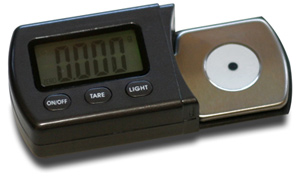![[SoundStage!]](../sslogo3.gif) The Vinyl Word The Vinyl WordBack Issue Article |
|
October 2007 CanRong CR-B5 Stylus-Force Gauge
The stylus-force gauge I used a decade ago -- a simple balance with counterweights -- required a lot of faith. I always used it properly, but I was never sure if the half-gram weight, for instance, actually weighed half a gram. Small weight variations in the counterweights could throw the VTF off enough to render the gauge nearly useless. Today's gauges, many of them with digital readouts, are accurate to more than one decimal place, but some ignore a few important design features. A stylus-force gauge needs to be small, comfortably fitting between the spindle and the edge of the platter, and easy to read. The weighing surface has to be at or very near the height of an LP, or the tracking force will be no more accurate at the record's surface than what I managed with my balance and counterweights. The surface also needs to be nonmagnetic, or the cartridge's magnets will be attracted to it, skewing results and perhaps damaging your cartridge. ShenZhen CanRong Mechatronic, a Chinese company that manufactures a wide range of electronic scales, balances and measurement tools, seems to have digested all of the information available on stylus-force gauges, because its CR-B5 addresses every important point. It is accurate to three decimal places and self-calibrating with an included 5-gram weight. Its weighing surface is about as thick as a 200-gram LP, so you won't have to worry that the VTF you measure is grossly different at the record's surface. The stainless-steel weighing area is nonmagnetic, so it won't attract the cartridge's magnets. The CR-B5 is small enough -- 3 3/4"W x 3/4"H x 1 5/8"D -- to fit easily on your turntable's platter, and it's lighted, running on a pair of LR43 batteries that are included -- along with a spare set. It comes with Chinese/English instructions and a case for storage. Using this gauge is a cinch. The weighing area is about the size of a nickel, so you won't have to drop your stylus onto a pin-sized indent. When you turn the CR-B5 on, it will stay illuminated for 20 seconds, then dim to save the batteries. You can turn the light on for 20 more seconds at the push of a button. The CR-B5 gives a reading to a thousandth of a gram -- it's so sensitive that your breath will register on the LCD readout -- so you can get anal over very small adjustments if that's your thing. I ignore the last decimal place and spend the extra tweaking time listening. If you forget to turn the CR-B5 off, don't worry. It shuts down on its own after two minutes of inactivity. How much should you pay for such a well-thought-out stylus-force gauge? This isn't a rhetorical question -- there are a number of valid answers. CanRong manufactures all of its products for others to resell, and this stylus-force gauge is available at a wide array of prices. I've seen it for as little as $50 on eBay and for as much as $185 from online retailers. Is there a chance that these are not the same item? CanRong has patents on this particular design, and it seems unlikely that a rogue company would copy it top to bottom. Even at almost $200, the CR-B5 is worth the cost; at $50, it's a bargain. You could use the money you save to buy a few 45-rpm reissues or a couple of shelves of garage-sale LPs. One thing you won't want to do with this gauge is weigh anything over 5 grams, because you could damage the weighing elements. If you need to weigh heavier objects in addition to setting your stylus force, CanRong makes versions that handle up to 40 grams. Some of the models you see online may be these. The CR-B5 is thoughtfully designed, easy to use, and highly sensitive. What it's not is sold at a fixed retail price. My advice is to check around and choose the source that offers it at the lowest price. If you get a lemon, the people at CanRong say they will honor the three-year warranty to the retailer, so you should be covered. ...Marc Mickelson
|
|
|
|
![[SoundStage!]](../sslogo3.gif) All Contents All ContentsCopyright © 2007 SoundStage! All Rights Reserved |
 Of all the fine adjustments
you need to make to your analog rig to ensure that it performs at its highest level,
setting the vertical tracking force (VTF) is arguably the most important. The VTF
determines how well the cartridge's stylus will track the record's groove, and it affects
the vertical tracking angle (VTA) or perpendicularity of the stylus in the groove. The VTF
also optimally aligns the cartridge's motor system, where the motion of the stylus becomes
an electrical signal. This may explain why small adjustments of VTF within a cartridge's
recommended tracking range can influence the sound heard to such a great degree. When
everything is right with the VTF, your records will sound their best, and your stylus
won't bounce around the groove or wear excessively.
Of all the fine adjustments
you need to make to your analog rig to ensure that it performs at its highest level,
setting the vertical tracking force (VTF) is arguably the most important. The VTF
determines how well the cartridge's stylus will track the record's groove, and it affects
the vertical tracking angle (VTA) or perpendicularity of the stylus in the groove. The VTF
also optimally aligns the cartridge's motor system, where the motion of the stylus becomes
an electrical signal. This may explain why small adjustments of VTF within a cartridge's
recommended tracking range can influence the sound heard to such a great degree. When
everything is right with the VTF, your records will sound their best, and your stylus
won't bounce around the groove or wear excessively.